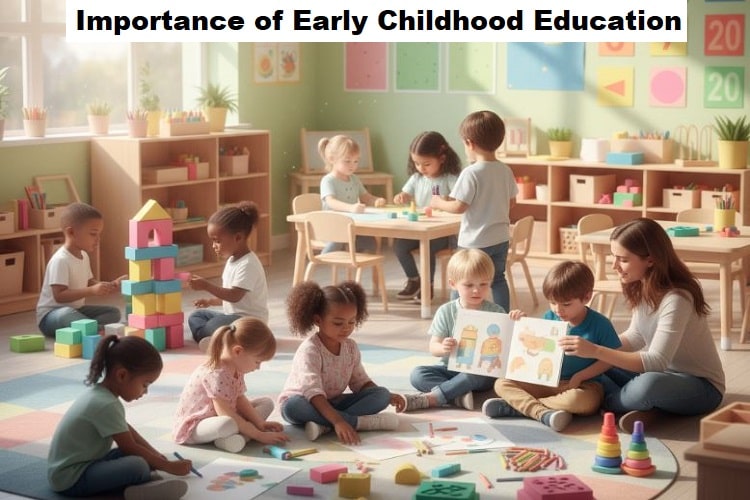Early childhood is the foundation of every child’s life. From birth to age eight, children experience rapid brain development that shapes how they think, learn, and grow. This period is more than playtime — it is the stage where children build the skills, habits, and relationships that prepare them for school and future success.
The importance of early childhood education cannot be overstated. High-quality care and education during these years not only benefit children but also support teachers, and society as a whole. Research shows that early learning has long-lasting effects, from better academic performance to improved social skills and even stronger economies.
This article explores what early childhood education is, why it matters, and the short- and long-term benefits it provides.
What is Early Childhood Education?
Early childhood education (ECE) refers to the teaching and care that children receive from birth through the early school years (typically up to age 8). This includes:
Preschool and pre-kindergarten programs
Daycare centers and early care settings
Home-based care with structured learning activities
Community early intervention programs
The importance of early childhood care and education lies in the combination of nurturing care, structured play, and guided learning. Together, these experiences give children the tools they need to thrive emotionally, socially, and academically.
The Science of Early Childhood Development
Children’s brains develop faster during early childhood than at any other stage of life.
By age five, more than 90% of brain growth has already occurred. This makes early years a “critical window” for learning.
Brain Development and Critical Periods
The brain forms millions of neural connections each second.
These pathways influence learning, memory, and problem-solving skills.
Early positive experiences strengthen these connections, while neglect or lack of stimulation can slow development.
Key Developmental Areas Supported by ECE
Cognitive growth: problem-solving, language, and critical thinking
Social-emotional skills: empathy, self-control, teamwork
Language development: vocabulary, storytelling, communication
Motor skills: coordination, balance, and physical health
In short, the importance of early childhood development is clear: investing in the early years pays lifelong dividends.
Immediate Benefits of Early Childhood Education
High-quality early education offers children advantages that appear quickly and support their school readiness.
Key Benefits
Improved school readiness: children start kindergarten more confident and prepared.
Stronger language and literacy skills: early reading and storytelling enhance communication.
Social skills and teamwork: children learn to share, cooperate, and solve conflicts.
Better focus and self-control: structured play teaches patience and discipline.
Example: A child who attends a quality preschool is more likely to recognize letters, understand numbers, and interact positively with peers by the time they enter primary school.
10 Key Benefits and Importance of Early Childhood Education
Early childhood education (ECE) is more than preparing children for school — it builds the foundation for lifelong success. From developing social skills to fostering creativity, quality early education influences every part of a child’s growth. Below are 10 powerful benefits that show why early childhood education is so important.
1. Cognitive Development
Children’s brains develop rapidly in their early years, absorbing information like sponges. Early education stimulates curiosity, problem-solving, and critical thinking. Structured play, storytelling, and exploration help children make connections and understand the world around them.
Why it matters: Early stimulation supports stronger memory, focus, and learning ability throughout life.
2. Social Skills and Emotional Resilience
Learning is not just about academics — it’s also about relationships. In early education settings, children learn to:
Share and cooperate
Express emotions in healthy ways
Show empathy and kindness
Why it matters: These skills build emotional resilience, helping children handle challenges and form positive relationships later in life.
3. Improved Problem-Solving Abilities
Play-based learning teaches children how to tackle challenges with creativity and logic. Activities like puzzles, role play, and sensory exploration encourage persistence and flexible thinking.
Why it matters: Problem-solving at an early age creates independent, innovative thinkers.
4. Healthy Use of Technology
When used thoughtfully, technology can support learning. Interactive games, digital storytelling, and multimedia can expand children’s understanding of the world.
Why it matters: Early digital literacy helps children use technology as a tool — not a distraction.
5. Language Development and Bilingualism
Early education is a golden window for building strong language skills. Exposure to storytelling, songs, and conversations enriches vocabulary. Bilingual programs also enhance memory, attention, and multitasking.
Why it matters: Strong language abilities improve communication, academic success, and career opportunities later in life.
6. Creativity and Imagination
Arts, music, and storytelling give children the freedom to express themselves. Creative activities spark imagination, helping children see problems and opportunities from different perspectives.
Why it matters: Creativity builds innovation — a skill valuable in school, careers, and life.
7. Parental Involvement and Support
Early education works best when parents are active partners. Schools that involve families through workshops, communication, and activities create stronger learning outcomes.
Why it matters: Parental involvement deepens the bond between parent and child while supporting better learning progress.
8. Building Independence and Confidence
Early education allows children to make choices, take initiative, and learn responsibility. Small tasks, like choosing activities or helping in class, boost their confidence.
Why it matters: Independence helps children grow into self-assured adults who can handle challenges on their own.
9. Long-Term Benefits
The question often asked is: What are the long-term benefits of early childhood education? Research shows children who attend quality programs are more likely to:
Do well in school
Pursue higher education
Succeed in their careers
Stay healthy and socially responsible
Why it matters: Early learning creates lasting advantages for both individuals and society.
10. Love for Lifelong Learning
Perhaps the most powerful benefit is the joy of learning. When children experience fun, curiosity-driven education, they associate learning with excitement rather than pressure.
Why it matters: A love for learning fuels curiosity and personal growth throughout life.
What Are the Long-Term Benefits of Early Childhood Education?
The impact of early learning doesn’t stop at kindergarten. Long-term studies prove that the advantages of early childhood education extend well into adulthood.
Education Outcomes
Higher test scores in school
Lower dropout rates
Greater likelihood of attending college
Economic & Career Outcomes
Higher earning potential in adulthood
Increased job stability and productivity
Reduced reliance on social assistance
Health & Social Outcomes
Healthier lifestyles and reduced stress
Lower involvement in crime or risky behaviors
Stronger family and community relationships
Societal Return on Investment
Every dollar invested in quality early childhood programs can return up to seven dollars in savings through reduced remedial education, healthcare costs, and criminal justice expenses.
Comparison Table
| Timeframe | Key Benefits |
|---|---|
| Short-term | School readiness, improved behavior, early literacy |
| Mid-term | Better grades, stronger social skills, reduced retention |
| Long-term | Higher earnings, better health, reduced crime rates |
Benefits of Early Childhood Education for Teachers
While early education primarily focuses on children, teachers also gain significant advantages from working within strong early learning systems.
These benefits not only enhance their professional growth but also improve classroom management & environments and long-term career fulfillment. Here are 10 key benefits of early childhood education for teachers:
1. Professional Growth and Development
Teachers gain deeper knowledge of child psychology, pedagogy, and modern teaching strategies. Continuous training and hands-on experience help them refine their skills and stay updated with the latest educational practices.
2. Increased Job Satisfaction
When classrooms are well-structured and children are better prepared, teachers experience less stress and more satisfaction. Seeing students thrive makes their work more rewarding.
3. Stronger Teacher-Parent Partnerships
Early education emphasizes collaboration with parents and caregivers. These partnerships build stronger communities and provide teachers with valuable support in nurturing each child’s growth.
4. Opportunities for Innovation
Teachers in early childhood settings can experiment with creative teaching methods like play-based learning, storytelling, and sensory exploration. This freedom encourages innovation and makes teaching more engaging.
5. Tangible Impact on Children’s Lives
Teachers see visible progress in children’s cognitive, social, and emotional development. Witnessing these results firsthand strengthens their motivation and reinforces their sense of purpose.
6. Leadership and Mentorship Roles
Strong early education programs often open doors for teachers to take on leadership roles, mentor junior staff, or guide parents, enhancing their professional reputation and confidence.
7. Better Work-Life Balance
Supportive classroom environments and collaborative teaching models reduce burnout. Teachers can manage their workload more effectively, leading to a healthier balance between work and personal life.
8. Lifelong Learning and Continuous Improvement
Engaging with children’s curiosity and adaptability keeps teachers themselves curious and motivated. They are constantly learning new ways to adapt lessons, use technology, and explore cultural diversity.
9. Recognition and Career Advancement
Successful early education systems highlight the value of teachers, often leading to recognition, promotions, and expanded career opportunities within education and child development fields.
10. Greater Fulfillment and Purpose
Ultimately, teachers find joy in shaping young lives and contributing to the foundation of future generations. This sense of fulfillment extends beyond the classroom, enriching their entire career journey.
Best Practices for Quality Early Childhood Care and Education
Not all programs are equal. To maximize impact, certain elements must be present.
Essential Features
Qualified teachers: trained in child development and ongoing professional training
Play-based curriculum: learning through exploration and creativity
Small class sizes: more individual attention for each child
Family involvement: parents as partners in learning
Inclusivity: support for children with disabilities and diverse cultural backgrounds
Assessment & feedback: regular progress checks without high-stakes testing
Checklist: Signs of a High-Quality Early Childhood Program
Low teacher-student ratio
Safe and stimulating environment
Clear learning goals
Active parent participation
Continuous teacher training
How Parents & Caregivers Can Support Early Development
Parents play a critical role alongside teachers. Here are some simple, daily actions:
Read to children regularly
Encourage play and imagination
Provide healthy meals and sleep routines
Limit screen time and encourage outdoor activity
Engage in conversations — ask questions and listen actively
These small habits, when consistent, make a big difference in early childhood development.
Policy, Access, and Equity
Access to early education is not equal everywhere. Many families face barriers due to cost, location, or lack of resources.
Universal Pre-K programs aim to provide access for all children.
Subsidies and scholarships help low-income families.
Equity focus ensures that children from marginalized communities have the same opportunities.
Creating policies that support early education is vital for reducing inequality and building stronger societies.
Measuring the Impact of Early Education
Schools, governments, and communities can measure success through:
Kindergarten readiness assessments
Third-grade reading levels
Family satisfaction surveys
Long-term data on graduation and employment
These metrics ensure programs are delivering real value to children and society.
Common Myths and Misconceptions
Myth: “Kids will learn later anyway.”
Reality: Early years are the most critical for brain development.Myth: “Preschool is just babysitting.”
Reality: Quality programs teach structured skills and habits.Myth: “Only disadvantaged children need early education.”
Reality: All children benefit, regardless of background.
Conclusion
The importance of early childhood education goes far beyond ABCs and playtime. It lays the foundation for lifelong learning, healthy development, and stronger communities.
By investing in children today — through quality programs, teacher support, and parent involvement — we shape a brighter, more equal future for all.
What is Special Education Teaching?
Role of Educational Psychology in Teaching and Learning
Why is Special Education Important To Teachers?
FAQs
What is the difference between early childhood care and early childhood education?
Care focuses on safety and nurturing, while education adds structured learning experiences. Both are essential.
At what age is early childhood education most important?
The most critical years are from birth to age five, when brain growth is fastest.
What are the long-term benefits of early childhood education?
They include higher academic success, better health, stronger earnings, and reduced crime.
How does early childhood education benefit teachers?
It supports professional development, improves classroom environments, and boosts teacher satisfaction.
How can parents choose a quality program?
Look for trained teachers, safe environments, small class sizes, and active parent involvement.

